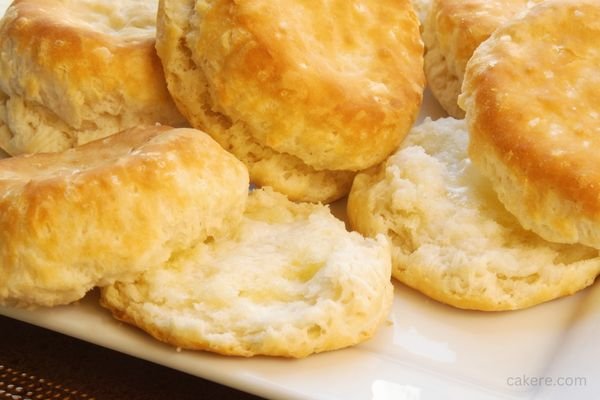Buttermilk is a versatile ingredient that can be used to make a variety of baked goods. In this article, we’ll explore the different ways you can use buttermilk in your baking, from cakes and muffins to biscuits and bread. We’ll also discuss the benefits of using buttermilk in your baking and share some tips for working with this tangy dairy product.

Benefits of using buttermilk in baking
Buttermilk is a fermented dairy product that has a tangy, slightly sour flavor. It’s commonly used in baking because it has several benefits, including:
Moisture retention
Buttermilk has a high water content, which means it can help keep baked goods moist and tender. This is particularly important in recipes that call for a lot of flour or dry ingredients.
Tenderizing agent
Buttermilk contains lactic acid, which can help tenderize the gluten in flour. This makes baked goods more tender and less chewy.
Leavening agent
Buttermilk is acidic, which means it can react with baking soda or baking powder to create carbon dioxide. This can help baked goods rise and become light and fluffy.
What can you bake with buttermilk?
Buttermilk biscuits
Biscuits are a classic Southern comfort food, and buttermilk biscuits are particularly delicious. Buttermilk biscuits are tender, flaky, and have a slightly tangy flavor that pairs well with butter and jam.
To make buttermilk biscuits, you’ll need flour, baking powder, baking soda, salt, butter, and of course, buttermilk.
Buttermilk pancakes
Buttermilk pancakes are light, fluffy, and have a tangy flavor that’s perfect for a lazy Sunday morning. To make buttermilk pancakes, you’ll need flour, baking powder, baking soda, salt, sugar, eggs, butter, and of course, buttermilk.
Buttermilk cornbread
Cornbread is a staple in Southern cuisine, and buttermilk cornbread is a classic recipe. Buttermilk cornbread is slightly tangy, tender, and has a slightly crispy crust. To make buttermilk cornbread, you’ll need flour, cornmeal, baking powder, baking soda, salt, sugar, eggs, butter, and of course, buttermilk.
Buttermilk cake
Buttermilk cake is a delicious dessert that’s perfect for any occasion. Buttermilk cake is tender, moist, and has a slightly tangy flavor that pairs well with fresh fruit or whipped cream.
To make buttermilk cake, you’ll need flour, baking powder, baking soda, salt, sugar, eggs, butter, and of course, buttermilk.
Buttermilk muffins
Buttermilk muffins are a delicious breakfast treat that’s easy to make. Buttermilk muffins are tender, moist, and have a slightly tangy flavor that pairs well with berries or nuts.
To make buttermilk muffins, you’ll need flour, baking powder, baking soda, salt, sugar, eggs, butter, and of course, buttermilk.
Buttermilk bread
Buttermilk bread is a delicious, slightly tangy bread that’s perfect for sandwiches or toast. Buttermilk bread is tender, moist, and has a slightly sour flavor that pairs well with savory or sweet toppings. To make buttermilk bread, you’ll need flour, yeast, salt, sugar, butter, and of course, buttermilk.
Tips for working with buttermilk
Use in marinades
Buttermilk can also be used in marinades for meat or poultry. The acid in the buttermilk can help tenderize the meat and infuse it with flavor.
To make a buttermilk marinade, combine buttermilk with herbs, spices, and other seasonings of your choice, and marinate the meat for several hours before cooking.
Don’t overmix
When working with buttermilk, it’s important not to overmix the batter or dough. Overmixing can cause the gluten to develop too much, resulting in tough or chewy baked goods. Mix the ingredients until just combined, and then stop.
Use fresh buttermilk
Fresh buttermilk is best for baking, as it will have the most active cultures and the highest acid content. If you don’t have fresh buttermilk, you can make a substitute by adding a tablespoon of vinegar or lemon juice to a cup of milk and letting it sit for a few minutes.
FAQs
Yes, you can use low-fat buttermilk in baking, but keep in mind that it may not be as tangy or flavorful as full-fat buttermilk.
Yes, you can substitute yogurt for buttermilk in many recipes, but keep in mind that yogurt may have a thicker consistency and a different flavor than buttermilk.
Buttermilk will keep for about a week in the refrigerator, but it’s best to use it as soon as possible for the freshest flavor and best results.
Yes, you can freeze buttermilk for up to 3 months. Thaw it in the refrigerator before using.
Leftover buttermilk can be used in a variety of recipes, from salad dressings and marinades to smoothies and mashed potatoes. Get creative and experiment with different flavor combinations!
Conclusion
Buttermilk is a versatile ingredient that can be used to make a wide variety of delicious baked goods. Whether you’re making biscuits, pancakes, or cake, adding buttermilk to the recipe can help keep your baked goods moist, tender, and flavorful.
Remember to use fresh buttermilk, don’t overmix, and experiment with different recipes and flavor combinations to discover new ways to use this tangy dairy product.
